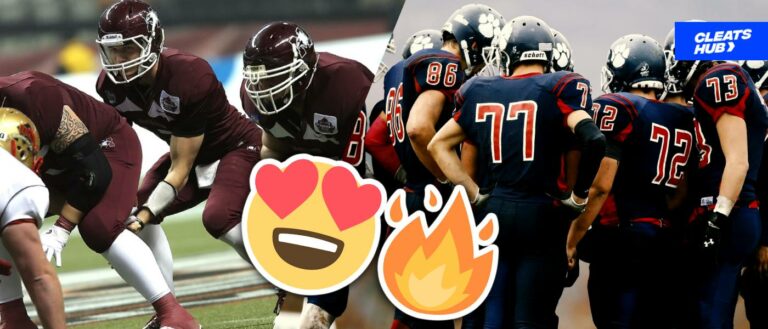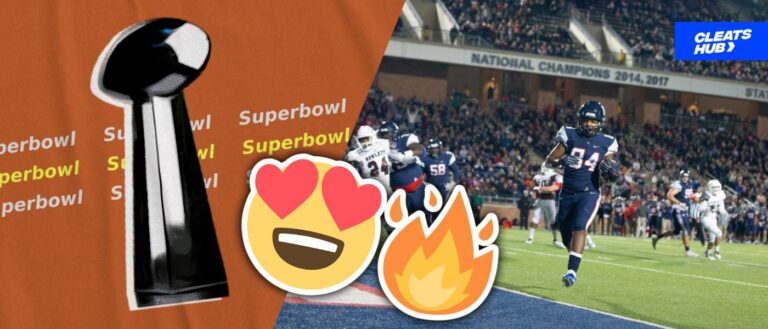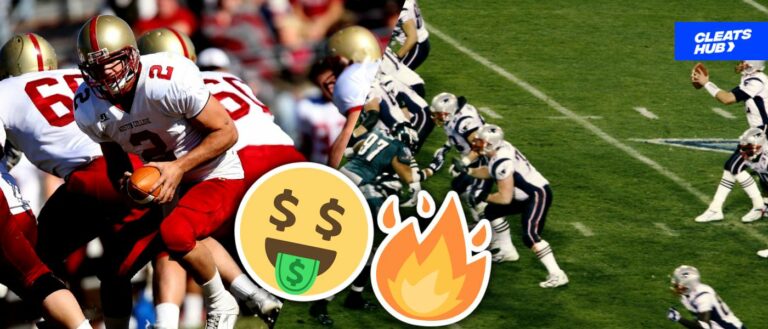What Is A Free Safety? Deep Dive
American football is the sport for you if you like a game of strategy, athleticism, and force. It is a difficult sport with multiple roles, each with its own set of responsibilities. Free safety is one such position. In this article, we will look at what it takes to be a free safety in American football here at Cleats Hub
What is a Free Safety?
On the defensive side of the ball is where the free safety is positioned. The primary responsibility of free safety is to break up or intercept passes and prevent the opposing team from scoring touchdowns.
They also observe the quarterback’s movements and estimate where the ball will be thrown while in the deep.
Furthermore, they are critical in stopping the run as well as playing against passes. They must be quick to recognize when the offense is rushing the ball. As a result, they may go forward to help tackle the runner.
Role of A Free Safety

A free safety is a defensive back whose main goal is to break up or intercept passes to keep the other team from scoring touchdowns. They are usually assigned the responsibility of watching the quarterback’s actions and predicting where the ball will be thrown.
Moreover, they need to be able to read the field well, respond swiftly to changing circumstances, and have exceptional eyesight.
Free safety is crucial to halting the run in addition to playing against passes. They need to be fast to spot when the offense is rushing the ball. As a result, they must be a flexible and high-reflex player who can stop the run as well as the pass.
Based on what he observes from the opposing offense, the free safety must also make defensive judgments and adjustments. To make sure that everyone is in the proper position and is aware of their tasks, they communicate with the other defensive players.
Skills Required to be a Free Safety

A player needs a specific set of abilities to succeed as a free safety.
- Reading Plays:
Free safety must also have excellent senses and be able to predict how the opposing offense will progress. To predict where the ball will be thrown, the free safety needs to be able to read the quarterback’s eyes and body language. - Speed and Agility:
They must possess extraordinary quickness, agility, and speed, as well as sharp vision and awareness. To intercept the throw, he must also have the quickness to adjust his course and respond to the receiver’s actions. - Tackling:
The free safety has defensive duties, but he also needs to be a great tackler. The runner must be able to be stopped in his tracks and must not be allowed to gain more yards after the reception. This necessitates that he possesses outstanding tackling skills and the capacity to land a forceful blow without endangering himself or others. - Communication:
The free safety must also be a superb communicator. To make sure that everyone is in the proper position and aware of their responsibilities. He must also be able to read the opposing offense and communicate with his teammates.
Types of Free Safety

The two most common free safety configurations in American football are single-high safety and split safety. Both types of free safety fulfill comparable roles, although their responsibilities and approaches differ in significant ways.
1. Single-High Free Safety
The more traditional of the two types of free safety is single-high safety. They frequently take up positions that are 12 to 15 yards from the line of scrimmage in the middle of the field.
Second, the single-high safety’s primary responsibility is deep coverage in order to prevent the other team from making long passes down the middle of the field. He needs to have outstanding range, quickness, and instincts to stop these passes.
The single-high safety must be nimble enough to recognize when the offense is running the ball and move up to help stop the run in order to effectively defend against the run.
2. Split Free Safety
Split safety, often known as the two-deep safety, is a more modern variation of the free safety position.
The split safety normally lines up farther back than the single-high safety, usually about 20 yards behind the line of scrimmage, as they are responsible for covering half the field.
Split safety is also frequently used in defenses that employ more zone coverage because it is responsible for intercepting deep throws down the sidelines. Also, they must be quick to the ball, have excellent coverage skills, and be able to read the quarterback’s eyes.
Techniques Used by a Free Safety

To be effective on the field, free safety in American football needs to possess a variety of tactics and methods. Some of the most crucial methods and tactics employed by free safeties are listed below:
1. Reading the Offense
One of the most crucial skills a free safety needs to possess is the ability to read the offense. The free safety must be quick to analyze the opponent’s formation, recognize the play being run, and anticipate the quarterback’s and other players’ on-field movements.
2. Coverage Skills
Yet another vital quality that free safeties must possess is excellent coverage ability. The free safety must be able to stop a variety of pass routes while covering a sizable section of the field.
They must be able to follow receivers on deep routes in addition to recognizing and breaking on short routes. The free safety must also have exceptional ball skills and the ability to intercept or break up passes.
3. Tackling Technique
The free safety needs to be skilled in tackling in both open regions and small quarters. In addition to being able to break down and make a powerful form tackle on a runner in the open field, they must also be able to come up and help their teammates stop the run.
Also, the free safety must be able to wrap up and bring down heavier runners and have a superb technique to avoid being juked or run over.
4. Communication
Communication is essential for free safety. They must be able to communicate with the linebackers and other secondary players in order to make sure that everyone is aware of their roles and is on the same page.
They must interact with the sideline coaches in order to notify them of the formations, inclinations, and play directives of the opposing team.
5. Pre-snap Adjustments
Free safeties must adjust their pre-snap defense in accordance with the offensive formation and play call. This can include completely altering the play call, adjusting the coverage, or rearranging the players.
The defense must recognize these situations and respond in order to place itself in the best possible position to stop the offense.
Top Free Safeties in NFL History

Some of the finest players in NFL history have played the free safety position. The top five free safeties in NFL history are listed below:
1. Ed Reed
Ed Reed is regarded by many as being the greatest free safety of all time. Reed participated throughout his career with both the Baltimore Ravens and the Houston Texans.
He was well known for his cunning play and excellent ball-hawking abilities. Reed was chosen for eight Pro Bowls, and five times Reed was chosen for the First Team All-Pro.
He was named the NFL’s Defensive Player of the Year in 2004
2. Ronnie Lott
One of the most versatile players in NFL history is Ronnie Lott, who played cornerback and free safety at different points in his career.
Hard-hitting player Lott played for the New York Jets, Oakland Raiders, and San Francisco 49ers throughout his career. Lott participated in 10 Pro Bowls and was selected eight times to the First Team All-Pro.
It is significant to remember that he was a four-time Super Bowl champion.
3. Paul Krause
Paul Krause was a member of the Minnesota Vikings and the Washington Redskins. He was praised for his exceptional ball sense, excellent covering skills, and mastery of opposition offensive analysis.
Krause was additionally inducted into the Pro Football Hall of Fame in 1998. He was a four-time First-Team All-Pro and an eight-time Pro Bowl participant.
4. Brian Dawkins
Brian Dawkins played for both the Philadelphia Eagles and the Denver Broncos throughout his playing career. He was well known for his forceful play and capacity for leadership on the field.
Dawkins was a member of the NFL 2000s All-Decade Team, a four-time First-Team All-Pro, and a nine-time Pro Bowler. Dawkins also participated in the 2004 Eagles Super Bowl team.
5. Willie Wood
Willie Wood played an important role on the Green Bay Packers championship teams in the 1960s. Wood was a ball hawk in addition to having excellent coverage skills and the ability to assess the opposition offense.
Also, in 1989, Wood was admitted into the Pro Football Hall of Fame. He was also a five-time First-Team All-Pro and a nine-time Pro Bowler.
Safeties with The Most Interceptions in NFL History
| Rank | Player | Interceptions |
| 1 | Night Train Lane | 68 |
| 2 | Ed Reed | 64 |
| 3 | Dave Brown | 62 |
| 4 | Willie Brown | 54 |
| 5 | Larry Wilson | 52 |
| 6 | Ronde Barber Jimmy Johnson | 47 |
| 7 | Sammy Knight Albert Lewis | 42 |
| 8 | Charlie Waters | 41 |
| 9 | Sam Madison Lindon Crown | 38 |
| 10 | Tony Greene | 37 |
Conclusion
In conclusion, free safety patrols the deep secondary to stop big plays. They are the last line of defense and the first line of attack, and they can change the course of the game.
Think of them as the Batman of the defense; they are always sneaking around, getting ready to intervene.
Whether they are intercepting passes or delivering crushing blows, free safeties are essential to the effectiveness of any defense. They hold the defense together, so anarchy would reign without them.







